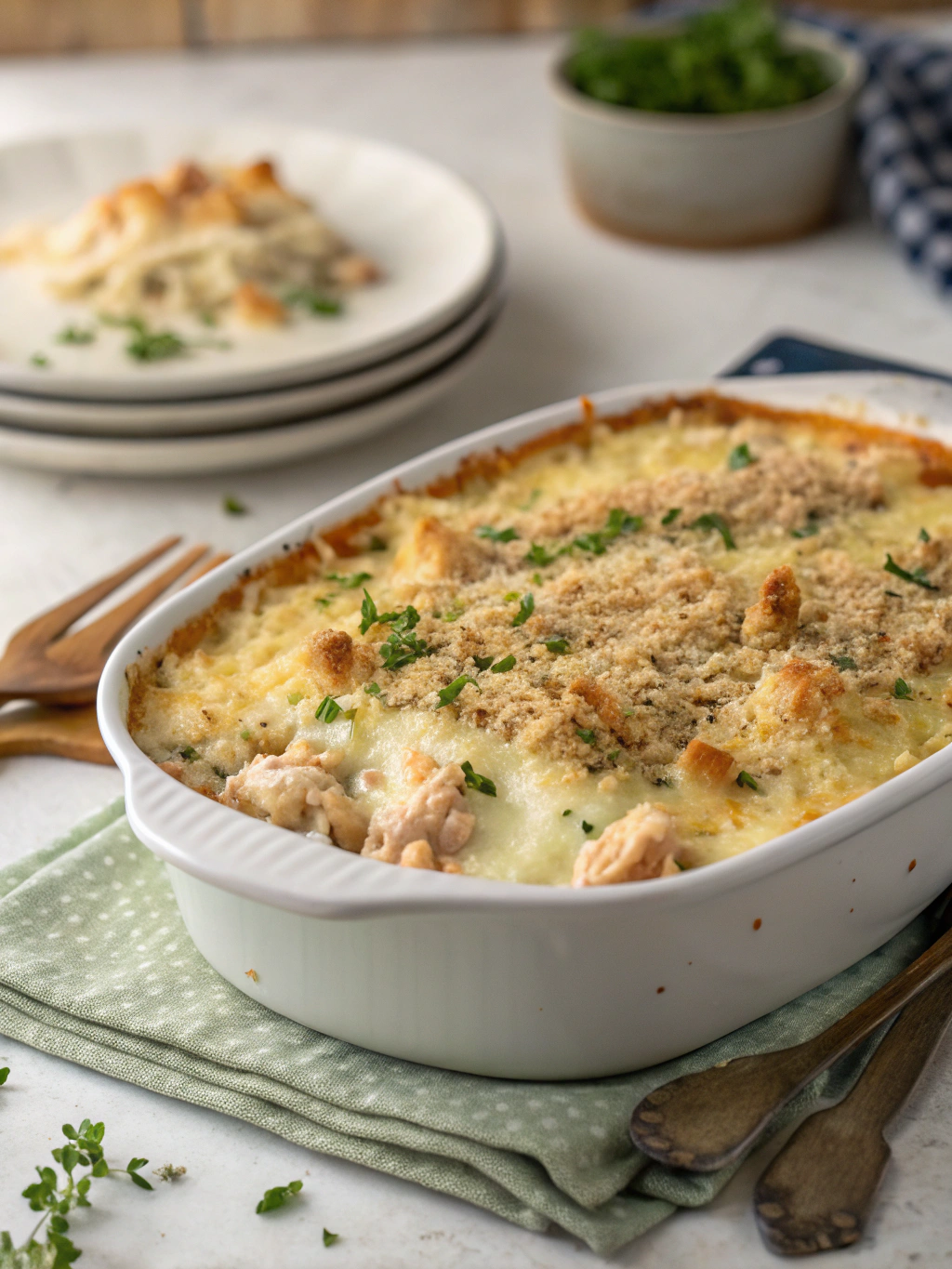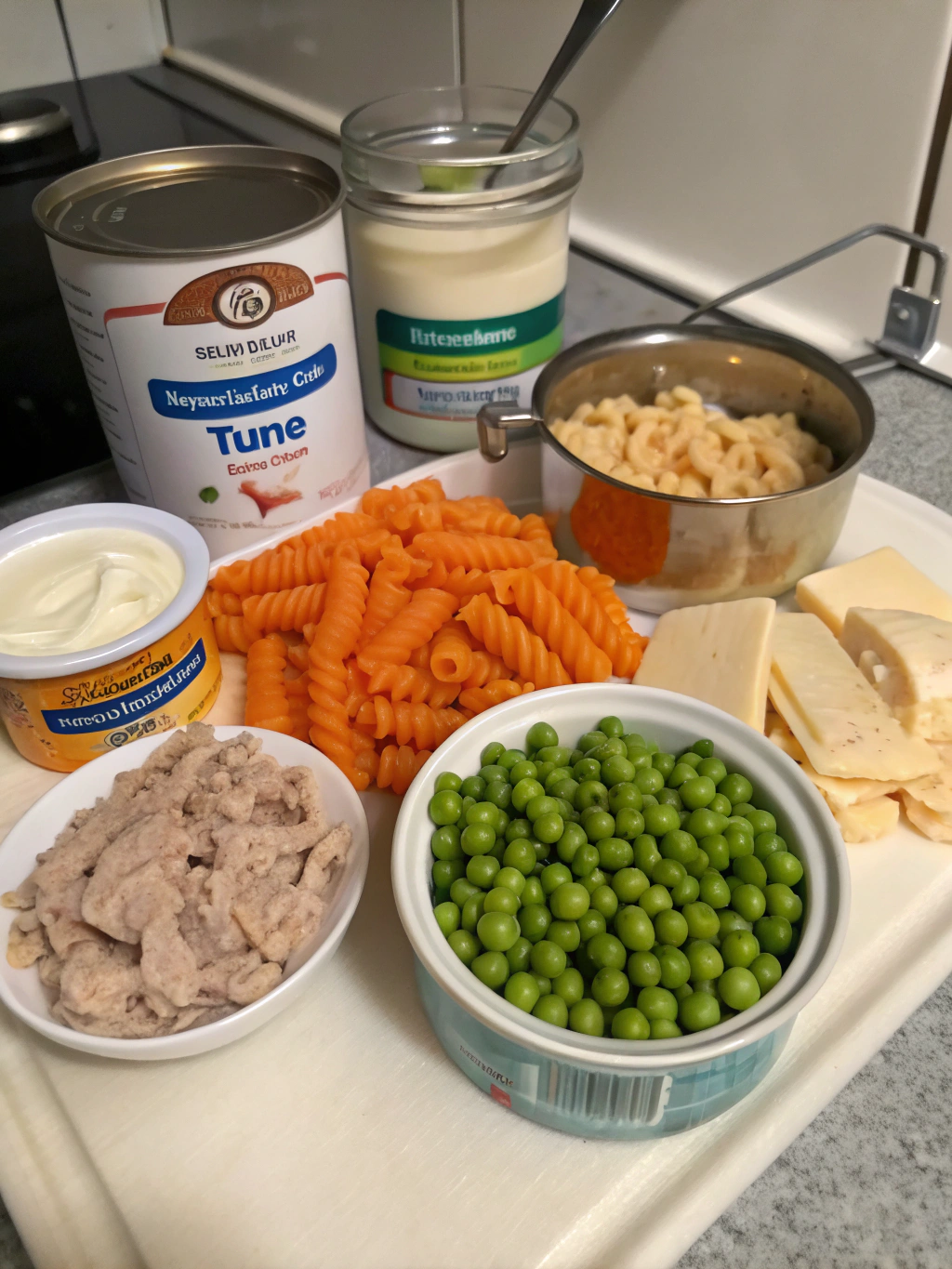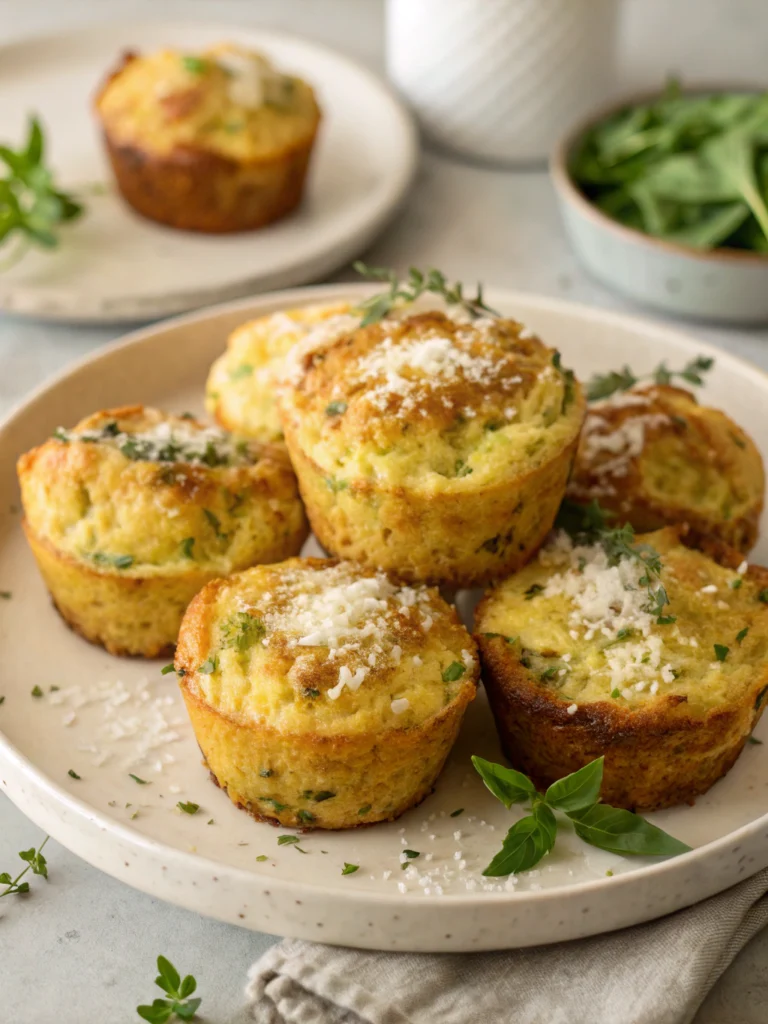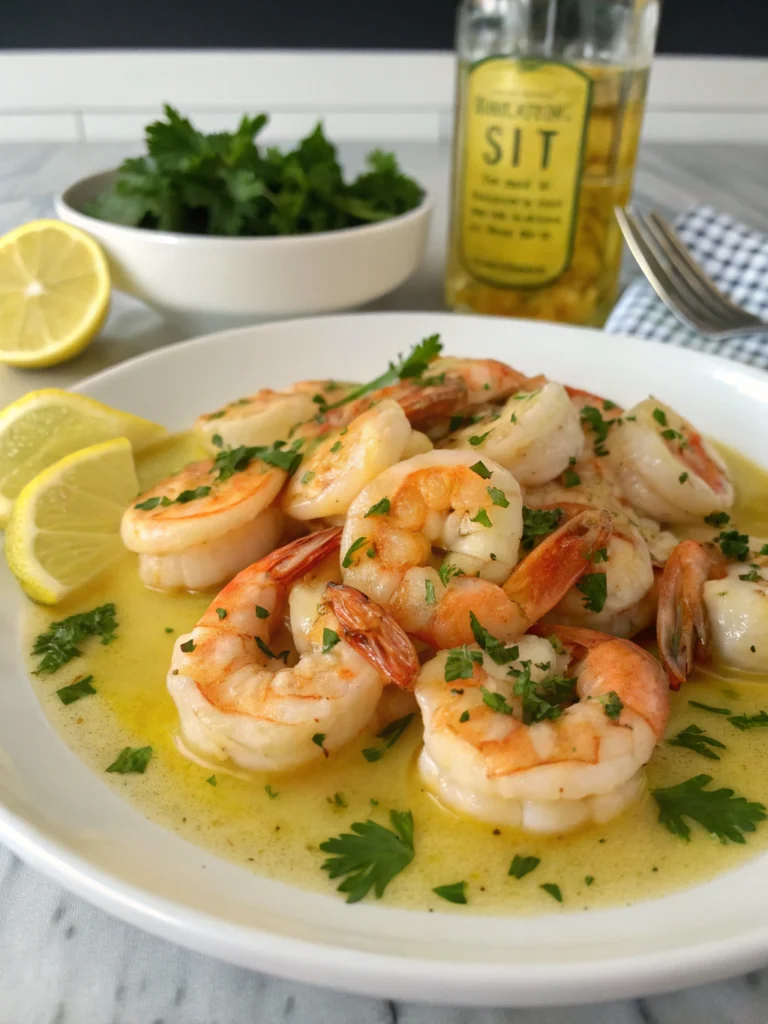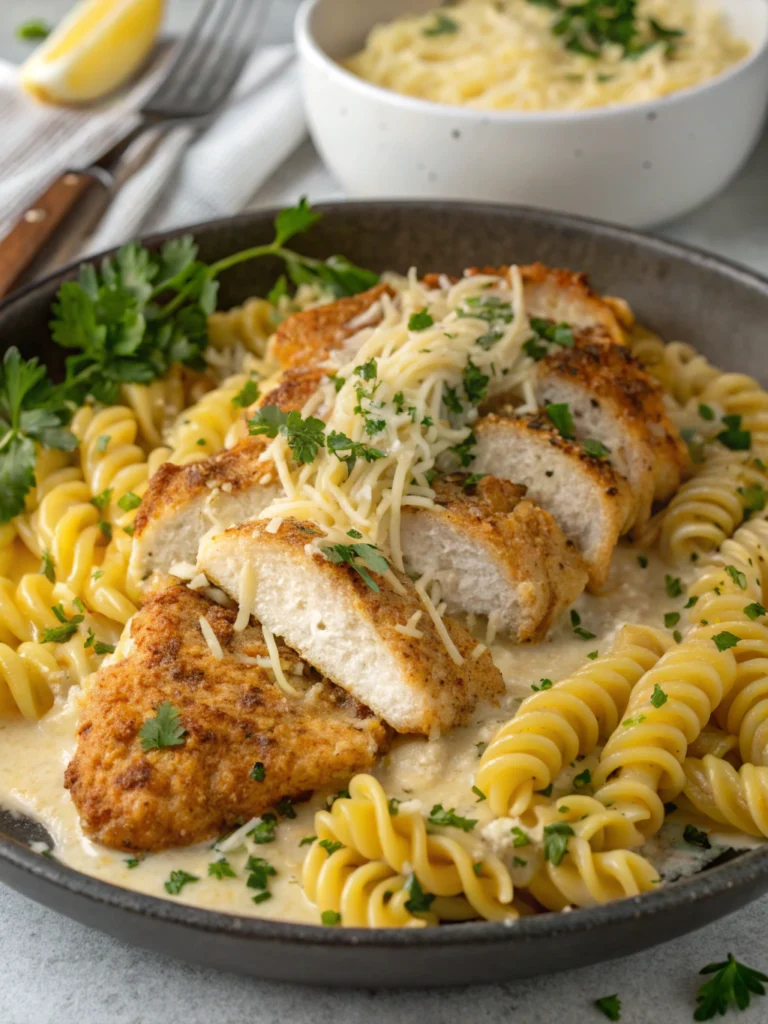Tuna Fish Casserole
This comforting tuna fish casserole combines flaky tuna, tender noodles, and a creamy sauce topped with a crunchy breadcrumb topping. Perfect for busy weeknights, this nostalgic dish transforms simple pantry ingredients into a satisfying family meal that’s both economical and delicious.
Easy Tuna Fish Casserole Recipe
There’s something wonderfully nostalgic about a homemade tuna fish casserole that brings back memories of family dinners around the table. This classic comfort food has stood the test of time for good reason – it’s simple, satisfying, and makes the most of budget-friendly pantry staples. What makes this particular tuna fish casserole recipe special is the perfect balance of creamy sauce, tender egg noodles, and flaky tuna, all crowned with a golden, crispy topping that adds wonderful texture contrast.
While tuna casserole has been a staple on American dinner tables since the 1950s, this updated version maintains all the comforting qualities of the original while incorporating fresh elements that elevate the flavor profile. It’s the ideal dish for chilly winter evenings when you crave something warm and substantial, yet it’s light enough to enjoy year-round.
THIS RECIPE:
- Uses simple pantry ingredients you likely already have on hand
- Comes together in under 45 minutes from start to finish
- Can be prepared ahead and frozen for future meals
- Features a made-from-scratch creamy sauce (no canned soup required!)
| Recipe Details | Information |
|---|---|
| Prep Time | 15 minutes |
| Cook Time | 25 minutes |
| Total Time | 40 minutes |
| Servings | 6 servings |
| Yield | One 9×13 inch casserole |
What makes this tuna fish casserole truly special is its versatility. You can easily customize it with vegetables you have on hand or adjust the seasonings to suit your family’s preferences. The homemade sauce takes just minutes to prepare but delivers richer flavor than any condensed soup version. Even those who claim not to like tuna often enjoy this casserole because the flavors meld so beautifully together, creating a dish that’s greater than the sum of its parts.
Ingredients for Tuna Fish Casserole
The quality of ingredients you select makes all the difference in elevating a simple tuna fish casserole into a memorable meal. While this recipe relies primarily on pantry staples, choosing the best quality components within your budget will enhance the final dish significantly.
Main Casserole Ingredients:
- 12 ounces egg noodles
- 2 (5-ounce) cans solid white albacore tuna in water, drained
- 2 cups frozen peas
- 1 cup diced celery (about 2 stalks)
- 1 cup diced onion (about 1 medium onion)
- 8 ounces button mushrooms, sliced
- 2 tablespoons butter (for sautéing vegetables)
- 1 teaspoon salt, divided
- ½ teaspoon black pepper
Creamy Sauce Ingredients:
- 3 tablespoons butter
- 3 tablespoons all-purpose flour
- 2½ cups milk (whole milk recommended)
- ½ cup chicken broth
- 1 teaspoon garlic powder
- 1 teaspoon dried thyme
- ½ teaspoon paprika
- 1 cup shredded cheddar cheese
Crunchy Topping:
- 1 cup panko breadcrumbs
- 2 tablespoons butter, melted
- ¼ cup grated Parmesan cheese
- 1 tablespoon fresh parsley, chopped
- ¼ teaspoon garlic powder
When shopping for tuna, look for solid albacore packed in water for the best texture and flavor. While chunk light tuna will work, albacore provides larger, more satisfying pieces and a milder flavor that works beautifully in this casserole.
| Ingredient Category | Recommended Quantity | Quality Tips |
|---|---|---|
| Tuna | 10 ounces total (2 cans) | Choose solid albacore in water; sustainable wild-caught if possible |
| Pasta | 12 ounces | Extra-wide egg noodles hold up best; high-quality dried pasta is perfect |
| Dairy | 2½ cups milk, 1 cup cheese | Whole milk creates the creamiest sauce; freshly grated cheese melts better than pre-shredded |
| Vegetables | 2 cups frozen peas, 1 cup each diced celery and onion | Fresh celery and onion provide better flavor; frozen peas work perfectly (no need to thaw) |
| Seasonings | As listed above | Fresh herbs can replace dried (use 3× the amount) |
How to Make Tuna Fish Casserole
Creating the perfect tuna fish casserole is about building layers of flavor while ensuring each component maintains its integrity. The process is straightforward but benefits from attention to detail, especially when making the creamy sauce that binds everything together.
Preheat and prepare: Begin by preheating your oven to 375°F (190°C). Lightly grease a 9×13 inch baking dish with cooking spray or butter.
Cook the pasta: Bring a large pot of salted water to a boil. Cook egg noodles for 2 minutes less than the package directions indicate (they’ll finish cooking in the oven). Drain well and set aside.
Prepare the vegetables: In a large skillet, melt 2 tablespoons butter over medium heat. Add onions and celery, cooking for 3-4 minutes until they begin to soften. Add mushrooms and cook for another 3-4 minutes until they release their moisture and begin to brown. Season with ½ teaspoon salt and ¼ teaspoon pepper.
Make the sauce: In a medium saucepan, melt 3 tablespoons butter over medium heat. Whisk in the flour and cook for 1-2 minutes until bubbling but not browned. Gradually whisk in the milk and chicken broth, stirring constantly to prevent lumps. Add garlic powder, thyme, paprika, and remaining salt and pepper.
Thicken the sauce: Continue cooking the sauce, whisking frequently, for about 5 minutes until it thickens enough to coat the back of a spoon. Remove from heat and stir in the cheddar cheese until completely melted and smooth.
Combine components: In a large mixing bowl, gently combine the undercooked noodles, drained tuna (flaked into chunks), sautéed vegetables, frozen peas (no need to thaw), and the creamy cheese sauce. Fold everything together carefully to avoid breaking up the tuna too much.
Prepare the topping: In a small bowl, mix panko breadcrumbs with melted butter, Parmesan cheese, chopped parsley, and garlic powder until evenly combined.
Assemble and bake: Transfer the tuna mixture to the prepared baking dish, spreading it evenly. Sprinkle the breadcrumb topping uniformly over the casserole. Bake uncovered for 20-25 minutes, until bubbling around the edges and the topping is golden brown.
Rest before serving: Allow the casserole to rest for 5-10 minutes before serving. This helps the sauce set slightly and makes it easier to portion.
Tips for Making Tuna Fish Casserole
Pro tip: For an extra-golden topping, place the casserole under the broiler for the final 1-2 minutes of cooking time, watching carefully to prevent burning.
- Choose tuna packed in water rather than oil for a cleaner flavor that complements the creamy sauce
- Don’t overcook the pasta initially – slightly undercooking ensures it won’t become mushy in the oven
- Hand-grate your cheese from a block for better melting (pre-shredded contains anti-caking agents)
- Let the casserole rest for 5-10 minutes after baking to allow the sauce to thicken slightly
| Technique | Recommendation |
|---|---|
| Sauce Consistency | If sauce seems too thick, add milk 1 tablespoon at a time; if too thin, cook slightly longer |
| Vegetable Preparation | Dice vegetables to similar size for even cooking; pre-cook mushrooms to remove excess moisture |
| Tuna Integration | Fold tuna in last and gently to maintain larger, more satisfying pieces |
| Breadcrumb Topping | Ensure butter completely coats breadcrumbs for proper browning and crispness |
When making the sauce, be sure to cook the flour and butter mixture (roux) for at least one minute to eliminate any raw flour taste. Add the liquid gradually while whisking constantly to create a silky-smooth sauce without lumps. If you prefer a casserole with more defined layers rather than fully mixed components, you can layer the ingredients in the baking dish instead of mixing them together.
Make-Ahead Instructions
One of the greatest advantages of tuna fish casserole is its make-ahead potential, perfect for busy weeknights or meal prepping.
To prepare 1-2 days ahead: Complete all steps through assembly in the baking dish, but don’t add the breadcrumb topping yet. Cover tightly with plastic wrap and refrigerate. When ready to bake, remove from refrigerator 30 minutes before baking to take the chill off, add the fresh breadcrumb topping, and bake as directed, adding 5-10 minutes to the baking time.
For individual components:
- Cooked vegetables can be refrigerated for up to 3 days
- Cheese sauce can be made 2 days ahead and stored in an airtight container (reheat gently before using)
- Breadcrumb topping can be mixed 3 days ahead and stored at room temperature in a sealed container
When reheating a fully-baked casserole from refrigerated, cover with foil for the first 15 minutes of reheating at 350°F, then uncover to re-crisp the topping.
Storing Leftovers
Properly stored leftovers make tuna fish casserole the gift that keeps on giving. After cooling completely, transfer leftover casserole to airtight containers or cover the baking dish tightly with aluminum foil or plastic wrap. Refrigerated leftovers will maintain quality for 3-4 days.
For optimal food safety, ensure leftovers are refrigerated within 2 hours of cooking. When reheating, make sure the casserole reaches 165°F throughout. The best reheating methods include:
- Microwave: For individual portions, heat on 70% power for 1-2 minutes, stirring halfway through
- Oven: Cover with foil and reheat at 350°F for 15-20 minutes, or until heated through
- Stovetop: For a creative twist, reheat portions in a skillet with a splash of milk to revitalize the sauce
Pro tip: Add a few tablespoons of fresh milk when reheating to restore creaminess that may have been absorbed by the pasta during storage.
Freezing Tuna Fish Casserole
This tuna fish casserole freezes beautifully, making it perfect for meal prepping or preparing in advance for busy periods.
For best results when freezing:
- Prepare the casserole completely but underbake it slightly (about 5 minutes less than called for)
- Allow to cool completely at room temperature (no longer than 2 hours)
- Cover tightly with a layer of plastic wrap, pressing it against the surface to remove air
- Add a second layer of aluminum foil or place in a large freezer bag
- Label clearly with contents and date
Frozen tuna casserole maintains quality for up to 3 months. When ready to enjoy:
- Thaw overnight in the refrigerator (never at room temperature)
- Remove plastic wrap, cover with foil, and bake at 350°F for 20-25 minutes
- Remove foil and bake an additional 5-10 minutes to re-crisp the topping
For best texture after freezing, consider adding a fresh layer of breadcrumb topping just before the final baking step, as the original topping may have softened during freezing and thawing.
Serving Suggestions
Tuna fish casserole is a complete meal on its own, but thoughtful accompaniments can create a more balanced dining experience.
Side dishes that complement tuna casserole perfectly:
- Simple green salad with vinaigrette dressing
- Steamed broccoli or green beans
- Roasted cherry tomatoes
- Crusty French bread or garlic bread
- Pickled vegetables for a tangy contrast
For a beautiful presentation, serve portions topped with a sprinkle of fresh herbs (parsley or dill), a light dusting of paprika for color, or a few additional breadcrumbs for extra crunch. Individual ramekins make for an elegant presentation for guests.
Beverage pairings depend on the occasion – a crisp Sauvignon Blanc or Pinot Grigio complements the creamy texture beautifully for adult diners, while sparkling water with lemon works for any age group. For casual family dinners, cold milk is the classic pairing that never disappoints.
The casserole should be served hot but not scalding – about 5-10 minutes rest time after removing from the oven strikes the perfect balance between temperature and texture.
FAQ
Can I use different types of pasta in tuna fish casserole?
Yes! While egg noodles are traditional, other short pasta shapes like rotini, penne, or shells work beautifully. Adjust cooking time according to package directions, always undercooking slightly (by about 2 minutes) since the pasta will continue cooking in the oven.
What can I substitute for mushrooms if I don’t like them?
You can simply omit mushrooms or replace them with diced bell peppers, zucchini, or even artichoke hearts. Each alternative will provide a different flavor profile and texture, but all work well in the overall dish. Adjust sautéing time according to your chosen vegetable.
My sauce is lumpy. How can I fix it?
Lumpy sauce typically happens when the milk is added too quickly to the roux. To fix it, remove from heat and whisk vigorously. If lumps persist, strain the sauce through a fine-mesh sieve, or blend with an immersion blender. To prevent lumps, add liquid gradually while whisking continuously.
Can I make this tuna fish casserole dairy-free?
Yes! Substitute the milk with unsweetened almond, soy, or oat milk (the latter provides the creamiest result). Use dairy-free butter and replace the cheese with a dairy-free alternative that melts well. Nutritional yeast (2-3 tablespoons) adds a nice “cheesy” flavor to dairy-free versions.
How can I add more protein to this casserole?
For extra protein, you can increase the tuna to 3 cans, add 1-2 cups of cooked, diced chicken, or mix in 1 cup of cooked white beans. Hard-boiled eggs, sliced and arranged on top before adding the breadcrumb topping, are another traditional high-protein addition that works beautifully.

